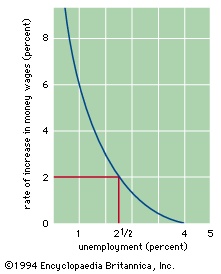Phillips curve
economics
 graphic-->
graphic--> representation of the economic relationship between the rate of unemployment (or the rate of change of unemployment) and the rate of change of money wages (distribution theory). Named for economist A. William Phillips, it indicates that wages tend to rise faster when unemployment is low.
representation of the economic relationship between the rate of unemployment (or the rate of change of unemployment) and the rate of change of money wages (distribution theory). Named for economist A. William Phillips, it indicates that wages tend to rise faster when unemployment is low.In "The Relation Between Unemployment and the Rate of Change of Money Wage Rates in the United Kingdom, 1861–1957" (1958), Phillips found that, except for the years of unusually large and rapid increases in import prices, the rate of change in wages could be explained by the level of unemployment. Simply put, a climate of low unemployment will cause employers to bid wages up in an effort to lure higher-quality employees away from other companies. Conversely, conditions of high unemployment eliminate the need for such competitive bidding; as a result, the rate of change in paid compensation will be lower.
The main implication of the Phillips curve is that, because a particular level of unemployment will influence a particular rate of wage increase, the two goals of low unemployment and a low rate of inflation may be incompatible. Developments in the United States and other countries in the second half of the 20th century, however, suggested that the relation between unemployment and inflation is more unstable than the Phillips curve would predict. In particular, the situation in the early 1970s, marked by relatively high unemployment and extremely high wage increases, represented a point well off the Phillips curve. At the beginning of the 21st century, the persistence of low unemployment and relatively low inflation marked another departure from the Phillips curve.
- digestive nerve plexus
- digestive system disease
- digestive system, human
- digestive system, invertebrate
- Digest of Operation Overlord
- Digger
- Diggs, Annie LePorte
- digit
- digital camera
- digital computer
- Digital Equipment Corporation
- digitalis
- digital sound recording
- digit malformation
- diglossia
- Digne-les-Bains
- Digul River
- Dihigo, Martín
- Dijon
- dika nut
- dik-dik
- dike
- Dikelocephalus
- Dikwa
- dilator muscle